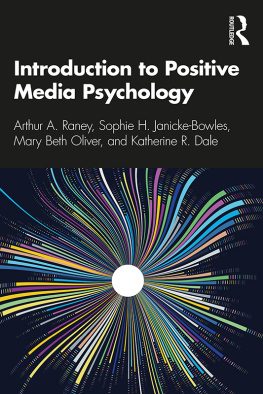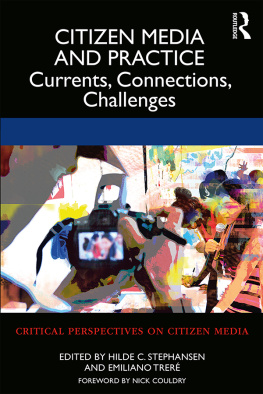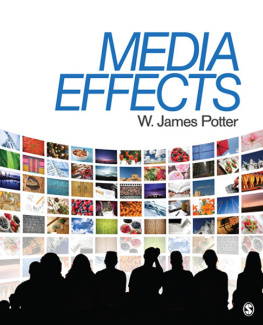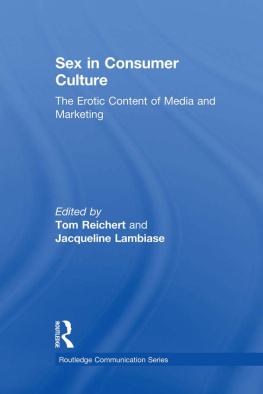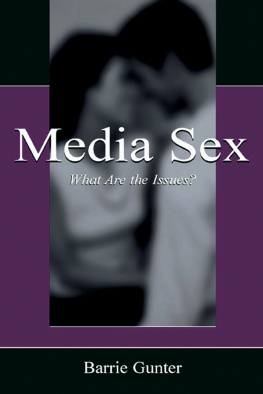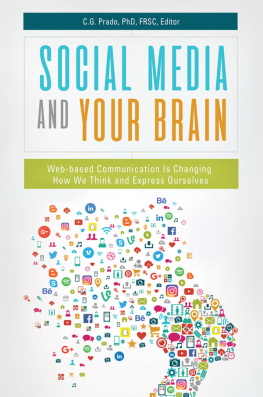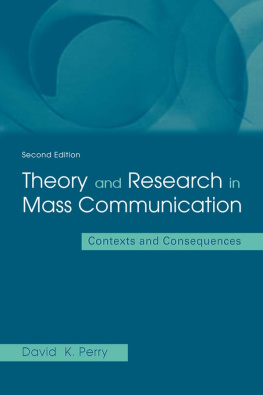Contents
Peter Vorderer, David W. Park, and Sarah Lutz
Patti M. Valkenburg and Mary Beth Oliver
Yariv Tsfati and Nathan Walter
David Tewksbury and Dietram A. Scheufele
Rick Busselle and Jan Van den Bulck
David R. Ewoldsen and Nancy Rhodes
Marina Krcmar
James Price Dillard
Melanie Green, Helena Bilandzic, Kaitlin Fitzgerald, and Elaine Paravati
Silvia Knobloch-Westerwick, Axel Westerwick, and Daniel J. Sude
Robin L. Nabi
Jonathan Cohen, Markus Appel, and Michael D. Slater
Paul D. Bolls, Ren Weber, Annie Lang, and Robert F. Potter
Jessica Taylor Piotrowski and Karin M. Fikkers
Paul J. Wright
Travis L. Dixon
Arthur A. Raney, Mary Beth Oliver, and Anne Bartsch
Louisa Ha
Amy B. Jordan and Sarah E. Vaala
Jessica G. Myrick
Arthur A. Raney and Jennings Bryant
Christoph Klimmt and Daniel Possler
S. Shyam Sundar and Jeeyun Oh
Jesse Fox and Bree McEwan
Scott W. Campbell and Rich Ling
Sriram Kalyanaraman and Jeremy Bailenson
Jinhee Kim and Kimin Eom
Guide
Peter Vorderer, David W. Park, and Sarah Lutz
Media effects research has been both praised and criticized for its role in a discipline called communication, communication studies, or even communication science. In fact, despite the rapid growth of the field and its seemingly constant differentiation, numerous influential volumes have been dedicated exclusively to media effects over the past 60 some years (e.g., Bryant & Oliver, 2009; Bryant & Zillmann, 1986; Nabi & Oliver, 2009; Perse, 2001; Schramm, 1954; Sparks, 2002). As much as the shaping of communication studies as a field was an outcome of media effects research, communication studies was of course not its only patron. Other and older disciplines like sociology, political science, or psychology also played important roles in the early theorizing and testing of hypotheses about the effects media technologies and messages may have on their users, and they still do.
In this chapter, initially we will focus on what communication originally meant across academia. Building on this, we will be able to differentiate between a few disciplinary traditions in communication studies and point to what may now be called the two official narratives of the history of media effects research. We will highlight the most important historical phases in communication research and will refer briefly to the often lamented (and sometimes also demanded) dichotomy between the social science and the humanities approach as it is manifested in our field. We will then refer to media effects in a more narrow sense, picking up on how its history has often been described and systematized along the lines of strong, weak, moderate, and negotiated effects. In order to summarize the most important theories of media effects research, we will refer to Kepplingers (2008) distinction between what he called learning theories and cognitive theories, and, subsequently, reconstruct the history of these theories and models by deriving them from their underlying epistemology. We will close this section by pointing to more recent theoretical developments, which are characterized by an attempt to differentiate and to integrate various components of the media-effects process. The final section will then lead us to the question of whether media effects still exist in todays media-saturated world, and, if so, what sort of effects remain in a world of ubiquitous media use. This, in turn, will bring us back to the roots of the field, in which communication was conceived as something significantly broader than what today is often meant when we talk about the uses and effects of media.
Five Models of Communication (and Then Four More)
Communication studies does not belong solely to scholars who identify with the field of communication. Even in the mid- to late-1900s, numerous and disparate intellectual traditions laid some claim to the study of communication, and the study of media effects must take its place within this broad spectrum of inquiry. In his pursuit of an inclusive means by which to sort out the tangle of ideas that have been applied to questions of communication, Peters (1999) took an historical perspective. More specifically, he turned to the 1920s, where he found an abundance of perspectives on communication that remain with us today. The first of theseand one that is particularly relevant to the study of media effectsis the understanding of communication as something like the dispersion of persuasive symbols in order to manage mass opinion (Peters, 1999, p. 11). In this understanding, communication was put into the context of other elements of modernity, including urbanization, industrialization, and rationalization. From such figures as Walter Lippmann, Edward Bernays, and Harold Lasswell came the idea that communication could be conceived of as the power to bind a far-flung populace together for good or ill (Peters, 1999, p. 12). This idea itself has proven quite powerful and undergirds much of the thinking concerning media effects today.
Though it is of particular importance for an understanding of media effects, this was by no means the only way communication was understood in the early 20th century. A second school of thought took communication to be the means to purge semantic dissonance and thereby open a path to more rational social relations (Peters, 1999, p. 12). The idea here, shared by Charles Kay Ogden and Ivor Armstrong Richards, is that communication breakdown on the macro- and micro-scales could be avoided through a careful consideration of how language comes to carry significance, an embrace of close semantic analysis that would provide a medium of communication for the needs of modern scientific men and women (Peters, 1999, p. 13).
This could be contrasted with a third model from the 1920s, which took communication to be an insurmountable barrier (Peters, 1999, p. 14). These barrier thinkers gave us a vision of communication in which language, gesture, and images all conspire to reinforce a condition of solipsism, where the pretense of mutuality and connection merely masks a situation wherein individuals simply seal themselves off or are sealed off by a system of communication. Peters (1999) traced this model of communication to Thomas Stearns Eliot and Franz Kafka, whose evocations of individuals walled off from others by language remain a potent poetic lodestar.
There are two more models that depart from the idea of communication as a mental process, or as a way to share an accurate depiction of the world. One of these Peters (1999) traced to philosophers Martin Heidegger and John Dewey. Heidegger saw communication not as the authentic connection between people but as the constitution of relationships, the revelation of otherness, or the breaking of the shells that encase the self and not as the sharing of private mental property (pp. 1617). John Dewey offered a different kind of end-around to the problem of communication. Peters (1999) described Dewey as having conceived of communication as pragmatic making-do in community life, and as taking part in a collective world (p. 18). Though he shared with Heidegger a turn away from conceiving of communication as authentic shared signification, Dewey gave us a more upbeat take with his focus on how communication can become a tool to solve shared problems.
A final model of communication that Peters (1999) extracted from the 1920s comes from Emmanuel Levinas. Peters (1999) described Levinas as having given us an understanding of communication as a caress (p. 20). From this standpoint, the failures of communication we find in all of these models is not something to mourn. Peters (1999) gave us a Levinas who argued that the:



